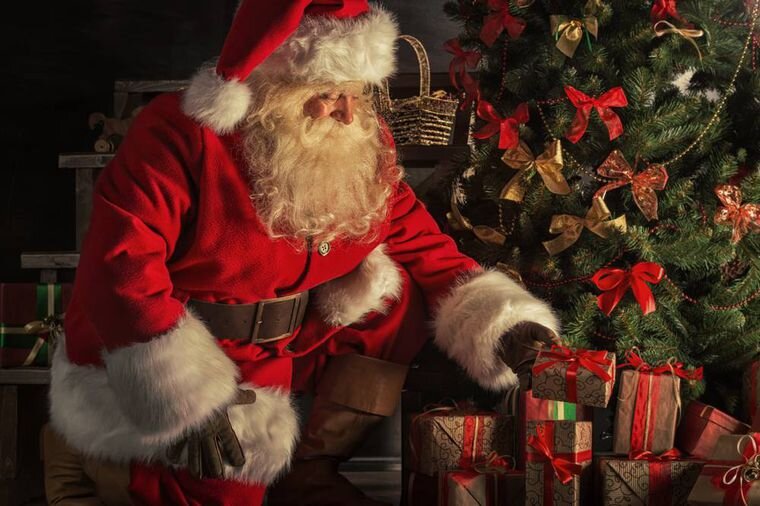How many different names for Santa Claus can you think of? I come up with ten, many of which are just variation of Saint Nicholas or Father Christmas.
The following was taken from Busuu. You can read the entire article here.
What is Santa Claus’ real name?
The concept originated from Saint Nicholas, a patron saint famous for giving generous gifts to the poor. The pronunciation of Saint Nicholas in Dutch is Sinnterklaas, which is where the name Santa Claus came from. Spelling Sinterklaas as Santa Claus dates back about 200 years in New York.
10 different names for Santa Claus around the world
1. English: Santa Claus / Father Christmas
In the UK, US and Canada, “Santa Claus” or “Father Christmas” is believed to travel around the world sporting a red suit on his sleigh, pulled by reindeer.
He comes down the chimney the night before Christmas (between 24 and 25 December), leaving presents for children under the Christmas tree! Children often leave Christmas stockings by the fireplace that Santa can fill with small gifts and sweets.
Some families will leave a snack for him for his travels. In the UK, it’s common to leave a mince pie (a traditional festive pastry) and a glass of whisky / sherry for Santa, and a carrot for the reindeer! Americans leave cookies and milk.
2. American-English: Kris Kringle
In the US and Canada, some people call him Kris Kringle, which originates from the German word Christkind (Christ child).
3. French: Père Noël / Papa Noël (lit. Father Christmas / Daddy Christmas)
In France, it is Père Noël who delivers presents either on the eve of 23rd December, or on the morning of 25th December.
In the east of France, he is accompanied by Le Père Fouettard, a man dressed in black, who is said to punish the children if they misbehave.
3. Spanish: Papa Noel (lit. Father Christmas)
The man behind the Spanish name for Santa Claus is commonly known to give out presents on 24th December or 25th December (from Papa Noel), or on 6th January (from the Three Kings).
In South America, a family member often dresses up as Papa Noel and gives gifts to the children.
While in countries like Mexico and Venezuela, presents might also be brought by El Niñito Dios (baby Jesus) or Santo Clós (Santa Claus).
Santa is actually Spanish and means “saint”. The only problem is that Santa with an “a” is used for women, such as Santa Maria, Santa Barbara, Santa Clara. Men use “San” or “Santo”, as in San Francisco, San Diego, San Antonio, etc.
4. German: Weihnachtsmann (lit. Christmas man)
The festive season in Germany starts early, with Nikolaustag – St. Nicholas Day – on 6th December. It is thought that St. Nicholas comes in the night, and puts presents in the children’s shoes, which are usually polished (kids have got to get in Santa’s good books somehow!) and placed by their front doors the evening before.
In some parts of Germany, das Christkind (Christ child) is thought to bring children presents on Christmas Eve. Children also write to him asking for presents before Christmas. They even decorate their letters by gluing sugar to the envelope!
In other parts of the country, der Weihnachtsmann (Santa Claus) is the one who brings presents to the children. Traditionally, German people open their presents on Christmas Eve rather than Christmas Day.
5. Italian: Babbo Natale (lit. Daddy Christmas)
In Italy, Babbo Natale is thought to deliver presents at Christmas. Italian families start collecting presents at the start of December and they are opened either on Christmas Eve or on Christmas morning.
It is also believed that the witch, La Befana, arrives during the night of 5th January bringing smalls gifts, sweets and dried fruits which she leaves in the socks of the good children.
6. Portuguese: Papai Noel (lit. Father Christmas)
In some parts of Brazil, children leave a sock near a window. If Papai Noel finds their sock, he’ll exchange it for a present.
In Portugal, Santa Claus is called Pai Natal. He is believed to bring presents to children on Christmas Eve. Presents are left under the Christmas tree or in shoes by the fireplace.
In both countries, families will either open presents on the eve of the 24th after Midnight Mass or on Christmas morning.
7. Russian: Дед Мороз – Ded Moroz (lit. Grandfather Frost)
In Russia, Christmas is actually celebrated on 7th January, which is the Orthodox Christmas, and therefore goes by a different calendar. This is true for many Easter Orthodox Christian denominations, such as those in the Middle East.
However, people do also exchange presents on New Year’s Eve. It is believed that Ded Moroz (the Russian and interpretation of and name for Santa Claus) brings presents with the help of his granddaughter, Snegurka. The tradition goes that children make a circle around the Christmas tree and call for Ded Moroz and Snegurka. When they appear, the star and other lights on the Christmas tree light up.
8. Turkish: Noel Baba (lit. Father Christmas)
Christmas isn’t widely celebrated in Turkey, but some families celebrate popular Christmas traditions on New Year’s Eve. They might have a ‘New Year’s Eve tree’ and give gifts.
9. Polish: Święty Mikołaj (lit. Saint Nicholas)
In Poland, it is generally believed that Święty Mikołaj brings presents which are opened after the Christmas Eve supper is finished. Sometimes the adults tease the children by dragging out the meal so they have to wait longer for the presents!
In some parts of Poland, there are different traditions. In the east, presents are given by Dziadek Mróz (the same as Ded Moroz in Russia) and in western and northern Poland people believe that Gwiazdor (the starman) brings them.
